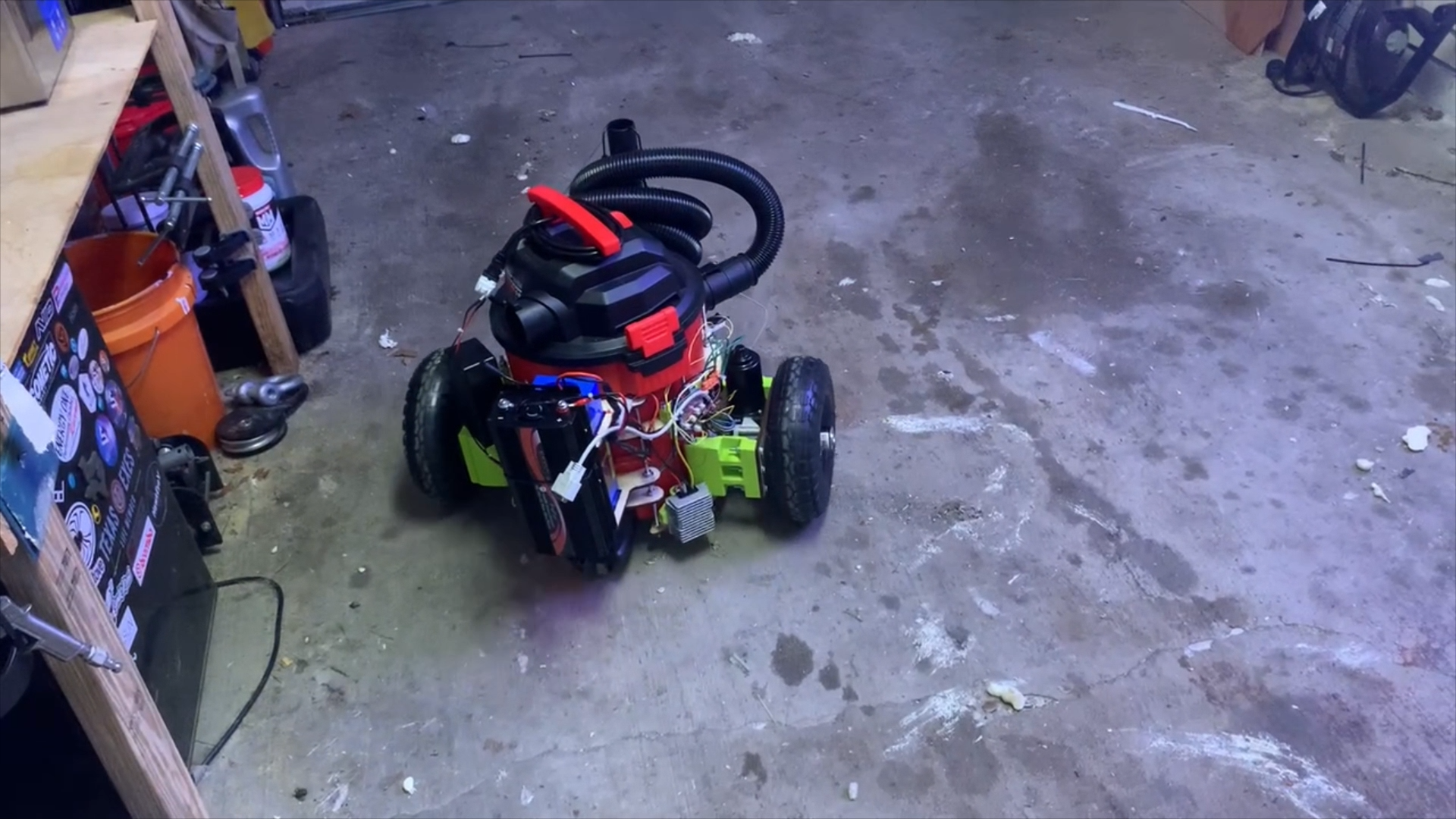MOAR
I turned a shop vac into an autonomous roomba style vacuum cleaner. The 4 horsepower beast uses 10” wheels, an ebike battery, and automotive windshield wiper motors to handle extreme tasks that a normal roomba cannot.
Project Video
In this video, I talk about the modifications I made to the shop vac and demonstrate it working to clean my garage floor.
The basic structural elements of the system were an exoskeleton made of laser cut wooden rings clamped against the bucket with nuts and threaded rods. 3D printed brackets connected the wheels and other electronic parts. I removed 2 of the 4 original caster wheels, and mounted the driven wheels slightly lower such that only 3 wheels would be on the ground at a time.
My exoskeleton rings being laser cut out of 1/4” plywood sheets.
This project runs on an arduino uno and a dual brushed dc motor driver. My proto-sheild connectorizes all the importent cable connections to the motors, sensor switch, gamepad, etc. a DC DC converter visible in the bottom part of the frame steps the 48v ebike battery down to 12v for the motors and arduino.
I mounted the harbor freight wagon wheels to my windsheild wiper motors with these steel adapter plates I had laser cut. They bolt through the two part wheel bolts and fit snugly against the flat sided output shaft of the drive motor. These wheels are not designed to be driven, they contain large bearings which I’m not using but the split rim design makes it easy to bolt on the adapter plate.
This bent coat hanger on the front of the vacuum is tied to a fishing line which routs to a mechanical switch. The coat hanger is preloaded to tension the string and hold the switch closed. When the robot bumps against an object, the coat hanger bends to relieve string tension and open the switch. This detects a collision, and the wheels turn the robot around. This mechanism worked remarkably well, even for collisions at oblique angles. Displacing the coat hanger in almost any direction would trigger the switch reliably. Hose clamps in the front kept the actual vacuum nozzle mounted just above ground level in front of the robot.
I test drove the robot around with this wired PS2 gamepad to get an idea for how it handled. It’s easily capable of turning in place, and has plenty of power to clear small bumps and obstacles.
A large inverter converts DC battery current to AC for the shop vac’s power source. This inverter was used, and was all I could find available for cheap. It’s limited to 1000W, which is not enough to operate the shop vac at its nominal maximum power of 4 horsepower (~3000W). Additionally, that greatly exceeds the nominal maximum continuous output current for the battery (30A at 48V = 1440W). In order to reduce the power consumption to safe levels, I added an array of load resistors to the power line for the induction motor, reducing its current draw significantly. This is somewhat of a hack; ideally I should’ve used a battery and inverter that could handle the expected current draw, but I was working on an extremely low budget with used parts and this was the simplest way to get it up and running.
See the images below for a few action shots of the vacuum cleaning some thick foam off of my garage floor. It handled this task fairly well overall. The vacuum nozzle is quite small, covering only about a 6” wide path. This means it has to drive around a lot to get a decent amount of floor coverage. Also, it struggles to access debris that is right up against walls or in corners.






After running continuously for 30 to 40 minutes, the current limiting resistors got hot enough to melt through their plastic enclosure and let some smoke through the vent holes. I stopped the test at this point. This project was somewhat silly but a lot of fun. I certainly wouldn’t trust this machine to run unattended, but it does show the potential utility of a heavy duty industrial robot vacuum.
Click the box above to view the code I wrote for this project on Github. It includes the autonomous driving mode, and the manual control with a PS2 gamepad.














